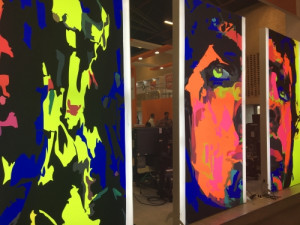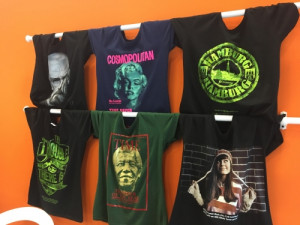Finding significant developments in digital textile printing in recent years is not an easy task since the technology has already reached its peak of innovation. Most research on digital textile printing today is concentrated on solving problems of already-popular systems, and the clue to finding them is where to look for them. New developments are there however. One of the new trends in digital printing is environmentally friendly products such as printed banners made of textile fibres using reactive and acid dyes and the LED by Oki system that I saw at the Andigrafica fair in Bogotá, Colombia.
Digital printing | by Maria José Leaño, www.papayad.com
 The biggest problems with digital printing on textiles are related to their disadvantages in comparison to traditional printing methods, such as how to increase printing speed, how to print on coloured garments without losing quality, how to print metallic colours and special effects, lowering printing costs and how to develop an ecological solution for the printing market. For this article I interviewed a group of experts in DTP whom I met at Andigrafica fair who know exactly what has been done in the last few years.
The biggest problems with digital printing on textiles are related to their disadvantages in comparison to traditional printing methods, such as how to increase printing speed, how to print on coloured garments without losing quality, how to print metallic colours and special effects, lowering printing costs and how to develop an ecological solution for the printing market. For this article I interviewed a group of experts in DTP whom I met at Andigrafica fair who know exactly what has been done in the last few years.
I-Tex Colombia
I-Tex Colombia is situated in Bogota and specialises in digital solutions for the textile industry, representing experienced digital printing developers such as Mimaki, Mtex and Oki. As a daughter company of Sing Supply, a very experienced company in the digital graphic industry, the idea of starting a new business in digital textiles in Colombia was a winner.
On the one hand Colombia’s textile industry has a long and well known tradition of over 50 years, which adds to its experience in digital textile printing service to the public of about 12 years, with Textil Digital as pioneer in 2007 and Estampamos S.A. since 2009, which is one of the few companies that offer DTP on natural fibres to countries around the region. In the production area many companies have used DTP for a couple of years longer, but are less well known, having very fast machines to complement traditional printing methods, thanks to its flexibility and design possibilities.
On the other hand textiles are seen today as an environmentally friendly process that could replace banner printing for publicity. This was demonstrated by I-Tex at the fair, its stand was decorated with banners made of textile fibres printed using reactive and acid dyes. With all these arguments in his hands, Dario Sarmiento and a group of professionals in textiles opened their doors to the textile industry, and things look very good indeed.
LED by OKI: printing on finished garments made simpler
Replacing traditional screenprinting on garments has been the main goal for digital developers; many solutions are already on the market with one of the biggest problems being to print on dark fabrics using white ink that does not clog the printing heads. Normally, the printers used piezo-electric heads developed by Epson, suitable for water-based inks for paper and textiles but not pigmented inks with big molecules like the white ink.
For this reason the development of garment printing split two ways, one was to create specialised printers with bigger print-heads to print faster and reduce the risk of blocking the print-heads. The other is to use paper-transfer printing; avoiding the problems of direct printing on the finished garment, and using a totally different kind of technology – LED printing.
 LED printing technology was developed inspired by traditional laser printing on paper, a system that has been in development by OKI for about 30 years, with the possibility to be used for textiles. Unlike ink-jet systems these printers do not use liquid ink; instead they use dry ink or a ‘toner’, a kind of chemically engineered plastic electrostatic particles, combined with pigments, specially developed for laser printers. It uses a photosensitive drum (one for each colour, normally CMYK or just one for black) that is being charged by a static laser beam directed to it, one dot at a time, using a complex set of moving optical lenses and mirrors. The charged dots pick up the electrically charged ink particles, transferring the image to the drum, which is then transferred to the paper using heat and pressure, all of this inside the printer. In this way the digital image is passed from the computer to the drum to the paper in a complex but smart system.
LED printing technology was developed inspired by traditional laser printing on paper, a system that has been in development by OKI for about 30 years, with the possibility to be used for textiles. Unlike ink-jet systems these printers do not use liquid ink; instead they use dry ink or a ‘toner’, a kind of chemically engineered plastic electrostatic particles, combined with pigments, specially developed for laser printers. It uses a photosensitive drum (one for each colour, normally CMYK or just one for black) that is being charged by a static laser beam directed to it, one dot at a time, using a complex set of moving optical lenses and mirrors. The charged dots pick up the electrically charged ink particles, transferring the image to the drum, which is then transferred to the paper using heat and pressure, all of this inside the printer. In this way the digital image is passed from the computer to the drum to the paper in a complex but smart system.
An LED system is similar in some ways but it uses one array of LEDs instead of the laser and mirrors for each colour, which charge the drum simultaneously in a strip of light, faster than the laser printer, and without all the moveable parts. This reduces the energy consumption of the printer while extending its life. The toner is designed especially for this specific technology, which, in the case of textiles, is combined with a polymer that attaches to cotton. The printer does not print on the garment directly, instead the image is printed on a special paper from where it is passed to the garment using a heat press, just as in a traditional transfer-printing system, with the advantage that only the ink is transferred to the fabric, not the paper, and there is no need to cut the image around it. The system has the possibility of having white ink that is already printed on the paper for transfer on dark garments without clogging the machine.
What is also amazing about this system is the possibility of using the printed image for metallic effects, using it as a base for metallic foil. In this case, the garment passes through the heat press twice, once to transfer the image from the printed paper and the second time to glue the foil to the fabric.
In conclusion, LED printers are a simpler technology than laser and ink-jet for printing on garments. They use less energy and produce fewer greenhouse gases, which makes it a more friendly system to the environment, one of the new trends in digital printing. Also, compared to direct digital-printing on garments it is a much less expensive solution, and therefore I suggest you take a look at it.
http://www.okidata.com/led-technology
From: Stitch & Print International issue 3-2017









